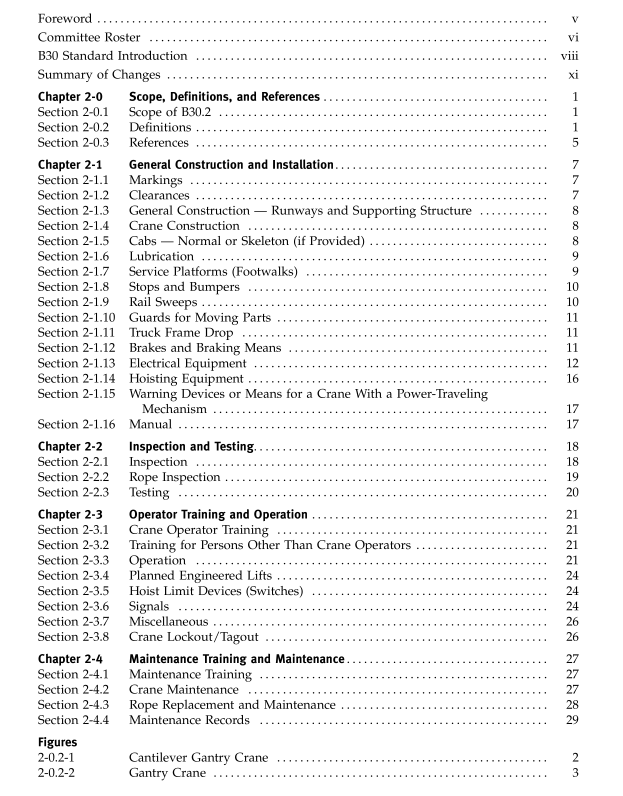ASME B30.2 pdf download

ASME B30.2 pdf download Overhead and Gantry Cranes (Top Running Bridge, Single or Multiple Girder, Top Running Trolley Hoist) Safety Standard for Cableways, Cranes, Derricks, Hoists, Hooks, Jacks, and Slings
SECTION 2-0.1:sCOPE OF B30.2
Volume B30.2 includes provisions that apply to theconstruction, installation, operation, inspection, andmaintenance of hand-operated and power-driven over-head and gantry cranes that have a top-running single-girder or multiple-girder bridge, with one or more top-running trolley hoists used for vertical lifting and low-ering of freely suspended, unguided loads consistingof equipment and materials (see Figs.2-0.2-1 through2-0.2-5). The requirements included in this Volume alsoapply to cranes having the same fundamental character-istics such as cantilever gantry cranes, semi-gantrycranes, and wall cranes.
Requirements for a crane used for a special purposesuch as, but not limited to, non-vertical lifting service,lifting a guided load, or lifting personnel are notincluded in this Volume.
(11)SECTION 2-0.2:DEFINITIONS
abnornal operating conditions: environmental conditionsthat are unfavorable, harmful, or detrimental to or forthe operation of a crane, such as excessively high orlow ambient temperatures, exposure to adverse weather,corrosive fumes, dust-laden or moisture-laden atmo-spheres, and hazardous locations.
adninistrative or regulatory authority: governmentalagency or, in the absence of governmental jurisdiction,the employer.
appointed: assigned specific responsibilities by theemployer or the employer’s representative.
authorized: appointed by a duly constituted administra-tive or regulatory authority.
auxiliary hoist: supplemental hoisting unit usually oflower load rating and higher speed than the main hoist.
boon (of gantry cranes): an extension of the trolley runwaythat may be raised or retracted to obtain clearance forgantry travel.
boom (of overhead cranes): a horizontal member mountedon the trolley to permit hoisting and lowering the loadat a point other than directly under the hoist drum ortrolley.
brake: a device, other than a motor, used for retardingor stopping motion by friction or power means.
brake, holding: a friction brake for a hoist that is automati-cally applied and prevents motion when power to thebrake is off.
brake , mechanical load: an automatic type of friction brakeused for controlling loads in a lowering direction. Thisunidirectional device requires torque from the motor tolower a load but does not impose any additional loadon the motor when lifting a load.
braking nmteans: a method or device used for stopping/holding motion by friction or power.
braking , control: a method of controlling speed by remov-ing energy from the moving body or by impartingenergy in the opposite direction.
braking , countertorque (plugging): a method of controllingspeed by reversing the motor line voltage polarity orphase sequence to develop torque in the direction oppo-site the rotation of the motor.
braking , dynamic: a method of controlling speed by usingthe motor as a generator, with the energy being dissi-pated in resistors.
braking , eddy current: a method of controlling or reducingspeed by means of an electrical induction load brake.braking , emergency: a method of decelerating a drivewhen power is not available. The braking effort maybe established as a result of action by the operator,orautomatically when power to the drive is interrupted.
braking, hydraulic: a method of controlling or reducingspeed by means of displacement of a liquid.
braking, mechanical: a method of controlling or reducingspeed by friction.
braking, pn1eumatic: a method of controlling or reducingspeed by means of compressed gas.
braking, regenerative: a method of controlling speed inwhich the electrical energy generated by the motor isfed back into the power system.
braking, service: a method to decelerate crane motionduring normal operation.
bridge: that part of a crane consisting of one or moregirders,trucks, end ties, footwalks, and drive mecha-nism, which carries the trolley or trolleys.
bridge travel: the crane movement in a direction parallelto the crane runway.
bumper (buffer): a device for reducing impact when amoving crane or trolley reaches the end of its permittedtravel,or when two moving cranes or trolleys comeinto contact.This device may be attached to the bridge,trolley, or runway stop.
cab: the operator’s compartment on a crane.
cab, ormal: operator’s compartment used for controllinga cab-operated crane.
cab , skelefon: operator’s compartment used for occasionalcab operation of a normally floor- or remote-operatedcrane.
cantilever frame: a structural member that supports thetrolley of a wall crane.
clearance: distance from any part of the crane to thenearest obstruction.
collectors,current: contacting devices for collecting cur-rent from runway or bridge conductors.
conductors, bridge: the electrical conductors located alongthe bridge structure of a crane that transmit control sig-nals and power to the trolley(s).
conductors, runway (main): the electrical conductorslocated along a crane runway that transmit control sig-nals and power to the crane.
controller: a device, or group of devices,that serves togovern, in a predetermined manner, the power delivereddirectly to the apparatus to which it is connected.
controller, nanual: a controller having all of its basic func-tions performed by devices that are operated by hand.









